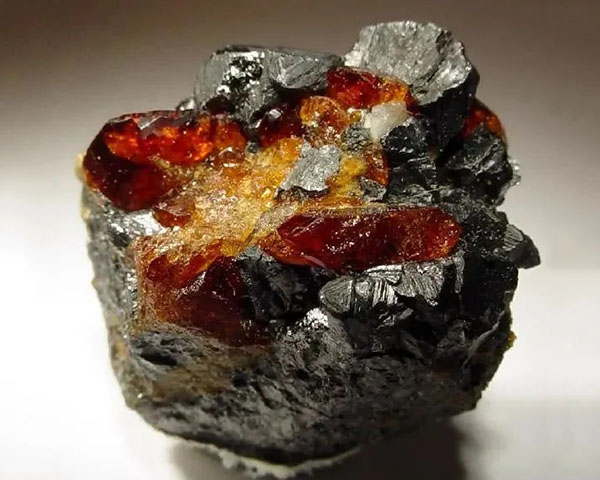Chondrodite is the most crucial gem mineral in the group of Humite. Chondrodite is widely distributed in the world, and gem-grade crystals mainly come from the United States, Switzerland, Finland, Italy, and Spain.
There are few gem-grade crystals, especially large-carat crystals. Gems are mainly used for collection. There is a round-faceted gem weighing about 2 carats in the New York Museum of Natural History.
- Monoclinic system,
- The crystals are plate columnar, and granular aggregates are common.
- Transparent to opaque,
- Glass to grease sheen.
- Color: yellow, brown, tawny and maroon, etc.
- Biaxial orthomorphic,
- Refractive index:1.61~1.65,
- Relative density: 3.16~3.26,
- Mohs hardness: 6~6.5.

Physical properties of Chondrodite
Chondrodite is yellow, green, red, brown, transparent, and semi-transparent – to opaque. The positive optical property of biaxial crystal, 2V=71 °~81 °, refractive index N=1.623~1.663, Nm=1.603, N=1.593~1.635, and birefringence 0.024~0.036.
With colorless, pale yellow, pale yellow pleochroism. It is inert under ultraviolet light; some are brown-orange fluorescence under long-wave ultraviolet light and have no characteristic absorption spectrum.
The cleavage parallel {100} is incomplete, the fracture is conchoidal, the Mohs hardness is 6~6.5, and the density is 3.161~3.264g/cm.
Where is Chondrodite from
Chondrodite is mainly produced in the contact metamorphic zone between dolomite and magmatic rock, in granular or vein shape, and coexists with magnetite, Humite, phlogopite, and fluophylline serpentine.
It is produced in Tilifest Mine, New York, United States, and produces red crystals. Yellow crystals are produced in the regions of Pagas, Sweden, and Finland.
Chondrodite Similar to Humite Group
Chondrodite
The word Chondrodite comes from the Greek word Chondros (grain), which means that this mineral is often produced as a granular aggregate.
Composition: (Mg, Fe) 5 [SiO4] 2 (OHF) 2
Form: monoclinic system. The crystals are tabular or irregular granular.
Photometric property: colorless or light yellow in thin slices. Weak Photometric: Np=light yellow-brown, Nm=light yellow, yellow-green, Ng=colorless, green, and the absorption are Np>Nm>Ng. Np=1.601~1.621,Nm=1.619~1.632,Ng=
1.637~1.655,Ng-Np=0.030~0.036.
The interference color is Grade II. Oblique extinction. With simple twinning or polycrystalline twinning.
Two axis (+), 2V=71 °~89 °.
Occurrence: It occurs in magnesia marble and magnesia skarn.
Identification: It is easy to mix with forsterite; the difference is that Chondrodite has color, weak pleochroism, and twin crystal.
Humite
Humite is named after Hume, the discoverer of the mineral.
Ingredients: (Mg, Fe) 7, [SiO4] 3 (F, OH) 2.
Form: It belongs to the orthorhombic system. The crystals are usually granular.
Photometric property: colorless to light yellowish brown in slices. It shows weak pleochroism. Np=light yellow, dark yellow, Nm=colorless, pale yellow, Ng=colorless, pale yellow. The absorbability is Np>Nm>Ng. Np=1.607~1.625, Nm=1.623~1643,
Ng=1.643~1.656,Ng-Np=0.028~0.038. Np//a,Nm//c,Ng//b,(+)2V=68°~81°。
Identification: The difference between Humite and Chondrodite is that Humite is parallel extinction.
Clinohumite
Ingredients: (Mg, Fe) 9 [SiO4] 4 (F, OH) 2.
Form: monoclinic system. The crystals are short-columnar, usually granular.
Photometric property: light yellow and yellow in thin slices. Weak pleochroism: Np=golden yellow, Nm=orange yellow, Ng=light yellow. Absorption is
Np>Nm>Ng.Np=1.625~1.658,Nm=1.638~1.678,Ng=1.653~1.700,Ng-Np=0.028~0.034。 Ng//b,Np∧a=7°~15°,(+)2V=72°~80°。
Identification: The difference between Clinohumite and Chondrodite is that the extinction angle of clinoptilolite is small.
norbergite
Norbergite composition is similar to that of Humite. Chemical formula (Mg,Fe2+)3(SiO4)(F,OH)2.
Orthorhombic crystal system, orthorhombic biconical crystal, but usually in the form of small granular or massive aggregates; Pale yellow to brownish yellow, transparent to opaque, glass luster;
Biaxial normal crystal,+2V=44 °~ 50 °;The Refractive index is Ng=1.590 ~ 1.593, Nm=1.567 ~ 1.579, and Np=1.563 ~ 1.567; The birefringence is 0.026~0.027;
Weak pleochroism: colorless to light yellow. Some have weak orange fluorescence under long-wave ultraviolet light. Hardness 6.5. The relative density is 3.16~3.26. Cleavage is not obvious. It occurs in contact metasomatic metamorphic belt and coexists with other Humite group minerals. It is found in New York, New Jersey, Sweden, etc. norbergite is rarely used as a gemstone.
How to identify Chondrodite
Chondrodite is easily mistaken for olivine, with the following differences:
Chondrodite is sometimes colored and absorbent in thin slices, while olivine is colorless;
The refractive index of Chondrodite is lower than that of olivine, and the protrusion of Chondrodite is moderate, while that of olivine is high;
Granodiorite has oblique extinction, while olivine has parallel extinction;Granodiorite has polycrystalline twins.
Conclusion:
The Humite family is a kind of layered silicate mineral that includes block Humite, Chondrodite, Clinohumite, and norbergite. Chondrodite is one of the Humite groups, often in the form of multiple aggregates. It is usually in the form of flaky twin crystals and blocks.
